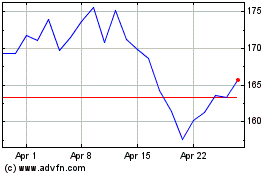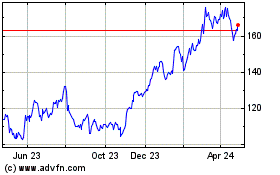NXP Deal Adds to Qualcomm CEO's Tumultuous Tenure
October 27 2016 - 4:29PM
Dow Jones News
By Don Clark
Steve Mollenkopf started his career as a chip engineer. But his
latest exploit might land him in the annals of financial
engineering.
Qualcomm Inc.'s chief executive is driving the semiconductor
industry's largest-ever acquisition, a $39 billion all-cash deal
for NXP Semiconductors NV that will transform Mr. Mollenkopf's
business, more than double the number of employees under his
direction and take Qualcomm into manufacturing for the first
time.
Mr. Mollenkopf acknowledged the challenges ahead in his
customary soft-spoken, confident style, the same tone he maintained
in recent years as Qualcomm weathered a major antitrust
investigation in China and high-profile pressure from an activist
investor.
"We've been through a lot," Mr. Mollenkopf said in an
interview.
But he said he "feels good" about his ability to oversee the
massive job of integrating NXP, a Netherlands-based company that
inherited sprawling semiconductor operations that began more than
60 years ago as operations of Philips NV and Motorola Inc.
"This feels like the type of ambition that is Qualcomm," Mr.
Mollenkopf said.
The deal, he said, should help Qualcomm more quickly move into
automotive chips and other products that are quickly adding
communications and processing power to cars. That push is
increasingly important as Qualcomm's core business in chips for
smartphones comes under pressure from slowing sales in that
market.
Mr. Mollenkopf, 47 years old, was promoted to CEO from chief
operating officer in 2014 after nearly 20 years at the company,
taking over from Chairman Paul Jacobs, the son of founder and
former CEO Irwin Jacobs -- the first person outside the Jacobs
family to lead the company. The company called the transition a
long-planned decision, but also indicated it may have been
accelerated by overtures from other potential employers.
An electrical engineer by training -- he studied at Virginia
Polytechnic Institute before earning a master's degree in the field
from the University of Michigan -- Mr. Mollenkopf has a distinctly
low-key personal style, even compared with the staid habits of his
predecessor. He said he currently drives an SUV, make and model
unspecified.
"I used to drive a Tesla," he said. "I'm waiting to get the next
one."
Mr. Mollenkopf spearheaded what had previously been Qualcomm's
biggest acquisition, a $3.1 billion deal in 2011 for Atheros
Communications Inc. that added a substantial business in Wi-Fi
chips.
That tie-up pales in comparison with the $39 billion deal to
acquire NXP, which has roughly 44,000 employees compared with
Qualcomm's roughly 30,000 by Mr. Mollenkopf's estimate. The Dutch
company, which last year completed the acquisition of Freescale
Semiconductor Inc., sells thousands of products to more than 25,000
customers. Qualcomm, by contrast, sells a much narrower line of
chips to scores of handset makers and other customers.
NXP also has seven factories that turn silicon wafers into
chips, manufacturing about half the products the company sells.
Industry executives say chip fabrication will require entirely new
skills of Qualcomm, which relies on external manufacturing services
to produce chips it designs.
Not only was Qualcomm a pioneer in the so-called fabless
semiconductor business model; Mr. Mollenkopf himself was the
chairman for two years of the Global Semiconductor Alliance, an
industry group originally founded to represent the interest of chip
companies without factories.
But Mr. Mollenkopf and some analysts say people tend to overlook
the expertise Qualcomm has built up over the years through
overseeing its manufacturing partners. He noted that the company
has been learning more about manufacturing issues through a joint
venture announced in January with Japan's TDK Corp. to make and
sell some kinds of wireless components.
Qualcomm will lean heavily on NXP's existing managers to oversee
day-to-day manufacturing operations, Mr. Mollenkopf said, noting
they successfully integrated Freescale's factories with their own.
"They learned a lot along the way," he said.
While Qualcomm is best-known for designing chips -- long used in
smartphones from the likes of Apple Inc. and Samsung Semiconductor
Co. -- the company gets more than half of its profit from licensing
wireless patents to handset makers. Such competitors and other
companies have at times complained to regulators about Qualcomm's
market muscle, leading to a string of antitrust investigations.
In February 2015, Qualcomm agreed to pay a $975 million fine to
Chinese authorities as part of an antitrust settlement, which also
included several changes to Qualcomm's practices in licensing
patents for mobile phones sold in China.
That business model came under more scrutiny the same year when
activist investor Jana Partners purchased a stake worth more than
$2 billion in Qualcomm and pressed for changes aimed at boosting
the company's share price. Qualcomm considered the possibility of
breaking its chip business apart from its patent-licensing
business, but wound up opting for other restructuring moves that
included $1.4 billion in expense cuts.
Mr. Mollenkopf argued that the investments Qualcomm makes in
inventing and patenting technology provide an advance look at what
features will be needed in chips as markets such as smartphones
evolve. The company, for example, has been deeply involved in
influencing the evolution of the next generation of cellular
technology, known as 5G.
Write to Don Clark at don.clark@wsj.com
(END) Dow Jones Newswires
October 27, 2016 16:14 ET (20:14 GMT)
Copyright (c) 2016 Dow Jones & Company, Inc.
QUALCOMM (NASDAQ:QCOM)
Historical Stock Chart
From Mar 2024 to Apr 2024

QUALCOMM (NASDAQ:QCOM)
Historical Stock Chart
From Apr 2023 to Apr 2024
